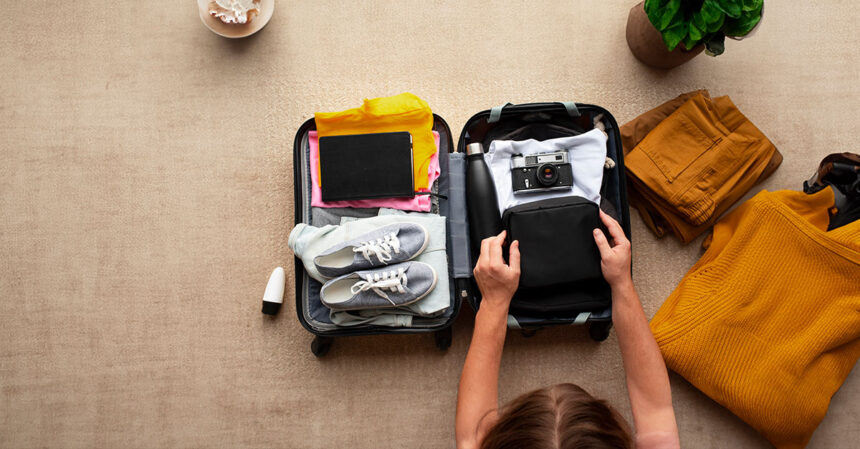Traveling to the United States can be an exciting experience, whether it’s for leisure, business, or adventure. However, one common obstacle travelers face is managing baggage costs, which can eat into your budget if not handled properly. Many airlines charge hefty fees for checked luggage, and carrying multiple bags can add up quickly. The solution? Packing light.
In this guide, we’ll explore practical tips for packing light when traveling to the U.S., helping you save money on baggage fees and ensuring a stress-free journey. Let’s dive into the essentials and strategies to pack smart and travel light.
1. Understand Airline Baggage Policies
Before you start packing, it’s crucial to understand the baggage policies of the airline you’re flying with. While many airlines in the U.S. offer free carry-on luggage, checked baggage typically comes at an additional cost. Each airline has its own rules regarding the number of bags you can check, weight limits, and size restrictions.
Some budget airlines in the U.S. are notorious for charging steep baggage fees. For example, Spirit Airlines, Frontier Airlines, and Allegiant Air may charge $30 to $50 for the first checked bag, while larger carriers like Delta, American Airlines, and United offer a more lenient baggage policy, but still charge for checked luggage on economy class tickets.
- Carry-On vs. Checked Baggage: The first step in packing light is to decide whether you can manage with just carry-on luggage. Most U.S. airlines allow one free carry-on bag and a personal item, such as a backpack or laptop bag. Carry-on bags are typically limited to 22” x 14” x 9” (56 cm x 36 cm x 23 cm), but it’s essential to check your airline’s specifications.
- Weight Limits: Airlines often impose weight limits for checked luggage, typically ranging from 40 to 50 pounds (18-23 kg). Overweight bags can incur a hefty fee, so pack wisely to avoid extra charges.
2. Choose the Right Luggage
The type of luggage you choose can significantly impact your packing experience. When traveling light, the key is to select a bag that fits the airline’s carry-on guidelines while providing enough space for your essentials. Here’s what you should consider when picking the right luggage:
- Rolling Carry-On: Opt for a compact, durable rolling carry-on bag. It offers easy mobility and fits the standard size for most U.S. airlines. A 20-22 inch roller bag is usually sufficient for a 1-2 week trip.
- Backpack or Duffel Bag: A backpack or a large duffel bag can also serve as an alternative to a traditional suitcase. These types of bags are lightweight, flexible, and can be compressed to fit more items.
- Compression Bags: If you’re packing bulky clothing, such as jackets or sweaters, consider using compression bags. These bags help reduce the volume of your clothes, allowing you to maximize space in your luggage.
3. Plan Your Wardrobe for Versatility
One of the best ways to pack light is by curating a versatile wardrobe. Choose clothes that can easily be mixed and matched, allowing you to create multiple outfits without packing excessive clothing. Here’s how you can plan your wardrobe smartly:
- Neutral Colors: Stick to neutral colors like black, gray, navy, and beige. These colors are easy to mix and match, and they work well with a variety of accessories. By selecting versatile clothing, you can wear the same items several times without anyone noticing.
- Layering: Layering is essential for dealing with changing weather conditions in the U.S. Depending on the region, the weather can vary greatly. Pack lightweight items that can be worn in layers, such as t-shirts, cardigans, jackets, and scarves.
- Multipurpose Items: Invest in clothing that can serve multiple purposes. For instance, a scarf can be worn as an accessory or used as a blanket on a chilly flight. A lightweight jacket can be worn during the day or at night to keep warm. Try to limit the number of items that only serve a single purpose.
- Avoid Overpacking Shoes: Shoes can take up a lot of space in your luggage, so be selective. Ideally, pack two pairs of shoes: one casual pair for everyday use (comfortable walking shoes, sneakers, or sandals) and one dressy pair for formal occasions. If you plan to visit a beach, pack flip-flops or water shoes.
4. Utilize Packing Cubes
Packing cubes are an absolute game-changer when it comes to packing efficiently. These small, zippered compartments allow you to organize your belongings in a way that maximizes space and minimizes wrinkles. By categorizing your items, you’ll be able to pack more items without exceeding the size limit.
- Sort by Categories: Use different cubes for specific items, such as one for toiletries, another for clothes, and a smaller one for accessories or electronics. This helps to keep everything organized and easily accessible.
- Compression Packing Cubes: Some packing cubes have a compression feature that allows you to squeeze extra air out of your clothes, making it possible to fit more into your bag.
5. Minimize Toiletries and Liquid Items
Toiletries can be another space and weight killer, especially when you’re packing light. Fortunately, there are a few tricks to minimize the number of toiletry items you bring with you while still having everything you need:
- Travel-Size Bottles: Instead of packing full-sized shampoo, conditioner, and body wash bottles, invest in travel-size containers. You can buy empty travel bottles and fill them with the products you need, ensuring they fit within the TSA liquid limits (3.4 oz or 100 mL per container).
- Solid Toiletries: Consider switching to solid toiletries such as shampoo bars, deodorant bars, or solid toothpaste. These products eliminate the need for bulky liquid bottles and are TSA-approved.
- Multi-Use Products: Look for multi-use products like a 2-in-1 shampoo and conditioner, or a moisturizer that doubles as sunscreen. These can save you valuable space in your bag.
6. Wear Bulky Items on the Plane
If you’re traveling with bulky items like a jacket, coat, or boots, wear them on the plane to save space in your luggage. While it might seem uncomfortable, the extra space you’ll save in your bag will be worth it. If the weather permits, you can also wear your heaviest shoes, like boots or sneakers, during the flight instead of packing them.
7. Pack Electronics Efficiently
When it comes to electronics, it’s tempting to bring multiple devices, but that can add unnecessary weight to your luggage. Here’s how to pack smart when it comes to electronics:
- Consolidate Devices: If possible, consolidate your devices. For example, bring a tablet instead of both a laptop and a phone. Many tablets offer functionality similar to laptops for checking emails, browsing the web, and watching videos.
- Minimal Accessories: Keep accessories to a minimum. A universal charger, portable power bank, and headphones are usually all you’ll need. Avoid packing extra cables or adapters unless necessary.
8. Consider Shipping Items Ahead
If you need to bring items like gifts or souvenirs that might be too large or heavy, consider shipping them to your destination in advance. Many U.S. destinations have reliable shipping services that allow you to send items directly to your hotel or Airbnb. This can save you the hassle of carrying bulky items and incurring extra baggage fees.
9. Use the Personal Item Space Wisely
In addition to your carry-on, airlines usually allow one personal item, such as a backpack, purse, or laptop bag. This is a valuable piece of real estate in your luggage strategy, so be sure to use it wisely:
- Essential Items: Pack essential items like your travel documents, medications, wallet, electronics, snacks, and a water bottle in your personal item.
- Quick Access: Keep items that you may need frequently (e.g., your passport, boarding pass, or phone) easily accessible in your personal item. This will save you time and frustration when you need to retrieve them quickly.
10. Leave Room for Souvenirs
Finally, leave a little room in your luggage for souvenirs or items you may pick up during your trip. This can be as simple as leaving a small corner of your carry-on bag empty or using the personal item space for extra purchases.




